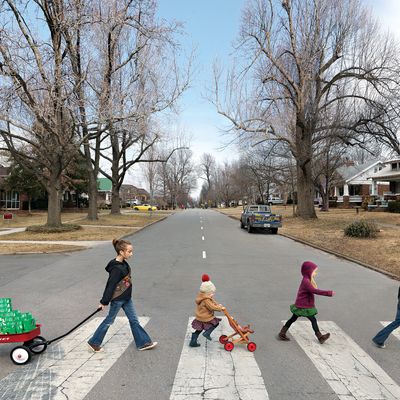
It’s easy to see why “universal pre-K” has become the calling card of so many Democratic politicians. Because, really, who can quibble? Universal pre-K, or preschool, as Hillary Clinton prefers to call it, helps families in two important ways. It puts 3- and 4-year-old children in a happy, safe place for most of the day, where they are exposed to letters and numbers and are forced to share, and it allows parents to go to work. Lately, it’s been seen as an achievement steroid, a school-performance boost especially powerful for those otherwise in need but an aid, truly, to everyone. It’s so much a win-win — so incontrovertibly good for kids, for parents, for the economy — that a buy-in from liberal constituents can be taken for granted; even purse-string conservatives offer only muted opposition. The craze for pre-K is also a sign of the political-educational times: Obama-era Democrats like to position preschool not as a compassionate cause (so 20th century) but as a data-driven “investment” in a techno-egalitarian, achievement-oriented future. Bill de Blasio made universal pre-K the centerpiece of his mayoral campaign, his rationale best articulated by his wife, Chirlane McCray. “Parents will rest a little easier knowing their kids will start out on the right path,” she intoned silkily in an early public-service announcement. “Let’s invest in their future — and ours.”
So it came as a shock last week when a report from Vanderbilt University — large, longitudinal, funded by the U.S. Department of Education (a proponent of universal pre-K) — showed that scaled-up, state-supported pre-K doesn’t work. Worse: It showed that kids in Tennessee who attended public pre-K fared less well, on academic and behavior scales, than their peers, most of whom stayed at home and presumably watched TV. One of the researchers, Mark Lipsey, said the results left him “stunned.”
But do the findings really mean what they appear to mean? Like many states, Tennessee has aggressively and enthusiastically ramped up its public pre-K offerings over the past decade and now serves 18,000 mostly at-risk children in 935 classrooms. (In this way, the program echoes a national effort to close achievement gaps between rich and poor, present from the very start of school, with what are essentially remedial curricula directed at getting poor children up to speed.) The Vanderbilt researchers selected about a thousand 3- and 4-year-olds from poor households — 700 were about to enter a public pre-K program and 300 weren’t. Then they gave all the kids, over four years, a regular series of achievement and behavioral tests and interrogated their teachers about performance. And what they found was indeed astonishing. For while the pre-K kids entered kindergarten better prepared for school in every sense than their stay-at-home peers, that advantage dissipated entirely by the end of the kindergarten year.
The big problem was not that the pre-K kids had gotten too early a start. It was that by the end of first grade, they lost their enthusiasm for school and felt more negatively about it than their classmates, and by the end of second grade, they were falling behind, academically. In an educational age of “readiness” and “achievement,” could school get so rigorous that it would undermine its own effectiveness? That is the semi-existential question posed by the study, since here, it seemed, pre-K was not only not a sound investment but also an impecunious one. On the local level, Republican opponents immediately began demanding to pull the plug. But even wonkish liberals found cause for doubt. “This study,” tweeted Ezra Klein of Vox, “is definitely making me rethink the value of universal pre-K.”
But the Vanderbilt study, like most social-science reports, is just one pixel in an immense landscape of findings going back decades — some of which have already shown that public pre-K is far from the panacea politicians promise it to be. “There’s a well-known ‘fade out’ effect,” says Robert Halpern, a professor at the Erikson Institute in Chicago. “In general, the literature for state-funded pre-K finds that the programs have moderately positive effects of various kinds. And then they disappear sometime in the early grades.” The Head Start Impact Study, published in 2010, followed 5,000 kids from preschool age through grade one. And researchers found that while Head Start kids were better prepared to enter kindergarten than their stay-at-home peers, the academic differences between the two groups essentially evaporated by the end of first grade. It also found that by the time they were 6, the kids who entered Head Start at 4 were shier, more socially reticent, and more troubled in their dealings with teachers and classmates, according to their teachers. (Perhaps they, too, had learned to hate school.)
These are all good studies, and they raise important questions. But none of them is an indictment of preschool, exactly, so much as an indictment of particular approaches to it. How do we know that? Two landmark studies, first published in 1993 and 2008, demonstrate definitively that, if done right, state-sponsored pre-K can have profound, lasting, and positive effects — on individuals and on a community. The first, known as the Perry Preschool project, followed 123 at-risk African-American children in Ypsilanti, Michigan, from the age of 3 or 4 (in the early 1960s) until they turned 40. Half went to the Perry Preschool, an enriched program that emphasized hands-on participatory learning. And half didn’t go to preschool at all. By 40, the people who attended the Perry Preschool were far more likely than the control group to have graduated from high school; to be earning decent incomes; to have an IQ of more than 90. Collectively, they had spent far less time in jail. In return-on-investment terms, the preschool kids paid back $12.90 for every taxpayer dollar spent. A similar program, called the Abecedarian Project, randomly selected about a hundred at-risk newborn babies and supported half of them, up until the age of 5, with preschool, as well as with home visits that included reading time and educational games. By 21, those in the preschool group scored better on intelligence and achievement tests and were likelier to have gone to college. They were also less likely to be teen parents or suffer from depression.
So preschool can be successful. The question is what distinguishes those that are from those that aren’t. And, questions of scalability aside (and these are not small questions), the short answer is that the good programs look a lot less like the rote-learning, test-focused elementary schools those kids are being “prepared” for and a lot more like the naïve sandbox ideal of preschool as a place to encourage a certain kind of structured, imaginative play. To be even more pointed: The best government-pre-K classrooms don’t resemble remedial education designed to bring impoverished 3-year-olds up to speed; they look like the progressive places most rich Americans have been sending their kids to for generations.
A friend of mine once called social science “banging your way through an open door,” and such is the case here. For the only conclusion to draw from all this research is that you can’t simply send kids to school, any school, and expect them to thrive. If a 3-year-old goes to a public pre-K that’s really just a kindergarten prep, housed in a building where everyone is freaked out about achievement gaps and performance measures, it may just be it’s too much to hope that the youngest children will remain immune to that stress.
Mark Lipsey speculated that the reason so many of the pre-K kids lost enthusiasm for school was that they ended up doing and learning the same things for three years in a row. His colleague Dale Farran toured the state’s classrooms, and in too many cases, she told me, 4-year-olds were expected to sit still and listen as a group, to follow instructions from a single teacher. They were not — as was the case in the Perry Preschool and the Abecedarian school — wandering around building towers and knocking them down, exploring their world and asking questions of teachers who had the time and the bandwidth to answer them and lead them deeper into inquiry. “When I would go into these classrooms,” Farran told me, “I would ask myself: Would I put my grandson in here? Because if I wouldn’t, then they aren’t good classrooms for anybody.” It’s not zipping up their coats and sending them to school that makes kids successful. It’s what they learn when they get there.
*This article appears in the November 2, 2015 issue of New York Magazine.





